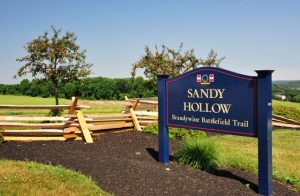Concord Township Planning Commission members still aren’t ready to recommend yea or nay on the development proposed for the Woodlawn Trustees property.
Following another three-and-a-half-hour meeting on Oct. 20, township solicitor Hugh Donaghue told a crowd dominated by opponents of the plan that the commission would announce its decision on Nov. 17.
John Jaros, the attorney for the applicant, agreed to give the township another 30-day extension. This means that the earliest the board of supervisors could vote on the plan would be December.
If the commission recommends approval and the supervisors agree, 229 acres of a 325-acre property — from the Delaware state line to Smithbridge Road, and in between Route 202 and the Concord border with Chadds Ford Township — would be developed with 160 homes on half-acre lots with 124 acres of gross open space, 97 acres after netting out rights-of-way and stormwater management areas. The development would be known as Vineyard Commons.
The 160 lots represent a reduction from 171 homes when the plan was presented in August. An original plan that was withdrawn in May 2013 called for more than 300 single-family homes, 120 townhouses, and an area for commercial development.
In announcing the delay, Donaghue said the commission wants the township sewer authority to review the sewage plans for the project on or before Nov. 5. The commission also needs time, he said, to study the Oct. 20 comments made by the township’s land-planning consultant and the Oct. 14 comments from the township engineer.
Donaghue added that the commissioners want township consultants to review a letter from Jaros relating to requested waivers. They also want to know, in writing, what the applicant intends to do with six historic sites on the property.
Jaros said one Class 1 historic structure would be kept, but that anyone who wanted the remains of the five Class 3 structures could have them free of charge.
One of the other concerns for those who oppose development of the Beaver Valley property is that the walking and equestrian trails would disappear.
Dennis Glacken, a land planner for the applicant, said slightly more than three miles of the original eight miles of trail would remain and another two-and-a-half miles would be added. There would also be six miles of paved sidewalks bringing the total walkable distance to more than 11 miles.
“People could still walk from point A to point B,” he said, “there would just be a different alignment.”
As for landscaping, the perimeter would be tree-lined, with a total of 4,600 new trees planted throughout the development.
Jaros said the current plan is a by-right option with the clustering permitted in the R2D Zoning District, but he was challenged on that point.
Julie Von Spreckelsen and Jack Michael represented residents who don’t want the development.
Von Spreckelsen said the application was deficient and did not comply with a variety of zoning, subdivision and land development ordinances as well as stormwater ordinances.
She gave the commission a letter citing 17 areas where the application is noncompliant, citing a few during her address.
She said the plan shows six cul-de-sac streets that far exceed the allowable length and that two of the six waiver requests were not in writing. She also argued that 54 acres would be clear-cut, that several of the lots were on steep slopes, which is against the code, and that others were too small to be code compliant.
Spreckelsen added that all of the required zoning variances had to be granted by the Zoning Hearing Board before the Planning Commission could recommend approval. She also said the applicant would need a variance to get rid of five of six historic structures.
She called the plan “fundamentally deficient,” adding that the violations must be dealt with before preliminary approval can be recommended and requested that the recommendation be denied.
Michael, who is also representing a resident, made a PowerPoint presentation that also cited the number of trees lost, specifically trees of 12-inch diameter or greater that are considered significant, and the loss of historic structures that he said, “represent our connection to the past.”
Jaros countered Michael’s and Von Spreckelson’s arguments by saying that township, county, state and federal regulatory bodies had reviewed the plans. They all commented favorably, he said, and recommended the plan go forward.
“Mr. Michael doesn’t want this development here,” Jaros said, “but there are property rights that let you do what you want as long as it’s legal.”
The audience, comprised of many people from the Save the Valley group who want the plan shut down, raised green cards when Von Spreckelsen and Michael made their points, while holding up red cards when Jaros and his witnesses made theirs. They also applauded for their side and jeered, booed or made other calls when the applicant’s representatives spoke. At one point, Donaghue told audience members not to shout out or they would be asked to leave.
To accommodate the large audience, the meeting was held at the Garnet Valley Middle School. The Nov. 17 meeting is also scheduled for the school auditorium at 6 p.m.
Woodlawn Trustees owns the property, but Eastern State Development Co. and McKee Concord Homes are equitable owners.
About Rich Schwartzman
Rich Schwartzman has been reporting on events in the greater Chadds Ford area since September 2001 when he became the founding editor of The Chadds Ford Post. In April 2009 he became managing editor of ChaddsFordLive. He is also an award-winning photographer.


 (7 votes, average: 3.71 out of 5)
(7 votes, average: 3.71 out of 5)
Comments